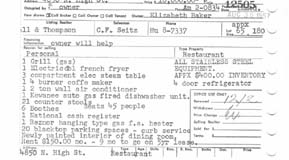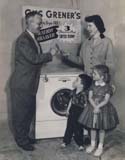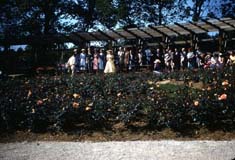Bob is Identified
Wednesday, November 11th, 2020 Last November, I posted a photo of a drugstore that carried a sign, “Bob is Home”. The photo spurred Clintonville Historical Society president Mary Rodgers to do some sleuthing. Here’s what she learned:
Last November, I posted a photo of a drugstore that carried a sign, “Bob is Home”. The photo spurred Clintonville Historical Society president Mary Rodgers to do some sleuthing. Here’s what she learned:
We have a photo in the Clintonville Historical Society’s archive that shows a storefront door with a sign that reads: “Closed Today –Bob is home after 5 years and 21 days in the Army for prescriptions call LA.5462 or LA. 9170”. I thought I might try to find out more about veteran “Bob”. From the sign, I know his name is Bob and that is most likely short for Robert. I know he served for 5 years and 21 days in the Army. I know this photo appeared in the Booster, a local newspaper founded in 1933 (post WWI-pre WWII). I went to Ancestry.com and searched for first name “Robert”, lived in Clinton Twp., Franklin County, OH with military service from 1941-1945 (i.e. WWII). The sign also told me that someone close to Bob owned a pharmacy (“for prescriptions call…”). I added pharmacy to my search. The top search results included Robert Ranck. Could this be the right solider? I went to the Columbus Metropolitan Library’s research site and pulled up the Columbus Dispatch newspaper. I typed in “Bob Ranck”. I found a newspaper article from November 14, 1945 that read as follows: “Druggists Back From Service Are Honored–Seven druggists and the son of another druggist who recently returned from the service were honored by the Servall Druggists Alliance at a dinner-dance at the Beechwold Tavern . Sgt. Bob Ranck, son of Paul Ranck, Oakland Park Av and High St. came home after five years in the service and his father promptly closed his store for the day…”.
Mystery solved! Jesse Paul Ranck owned the Oakland Park Pharmacy–where Shim’s is today. The Ranck family lived at 234 Erie Road. Mr. Ranck was very involved in the Clintonville community. He loved nature and was an avid hunter and fisherman. In 1959, the Columbus Dispatch reported that then retired Pharmacist Ranck continued to visit the shop at Oakland Park and High. On one particular day, May 8, 1959, he told the story of a mother raccoon who had brought her babies down the chimney of his home. He was worried that the kits would become too heavy for her to remove. His son, Bob Ranck, returned from the war and attended The Ohio State University. He graduated from the School of Dentistry. For many years, his dental practice was above the Oakland Park Pharmacy. According to his 2012 obituary, he ultimately received the military rank of Captain and was awarded the Bronze Star for his heroic service to our country.
[Image is from The Booster, and courtesy of the Hollenback Collection at the Clintonville Historical Society. Mary’s article was published in the May 2020 CHS Newsletter.]


































